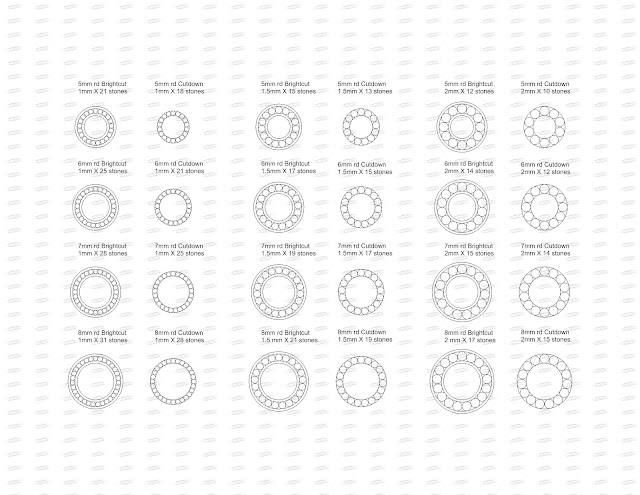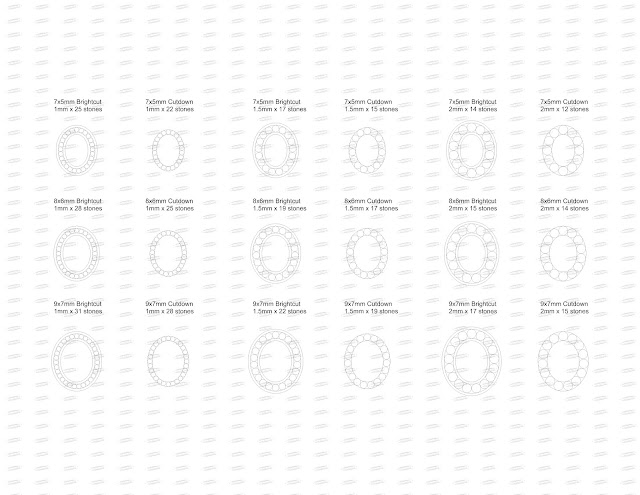Designing Halos with Melee Gems
In the past year, my business has increasingly developed toward custom projects and quotes. This brings with it a lot of design challenges, and in order to simplify matters a bit on my end, let me share with you some useful information about gemstone melees and how to think about designs involving them. A melee is considered any gem that is 3mm and smaller.
First, note that not all gems come in all sizes. For anything under 1mm, there are really just diamonds available. Most colored stone melees come in 2mm and up, sometimes 1.5mm and up, and not everything comes in melee.
To calculate the weights of diamond melee, you might use a chart like this one:

Colored gems are often a little bit deeper and a little bit denser in their structure, so they weigh more, too. The most easily available colored stone melee are sapphires and rubies, but as you know from my shop I also have many others: aquamarine, zircon, mandarin garnet, color change garnet, spinel, tsavorite, mint garnet, peridot, tanzanite, chrysoberyl, among others. I collect melees because I use them a lot in designs, but for the most part, they are not readily available on the gemstone market. I don't have all of these in all sizes so you'll have to ask. Some are hard to replace (i.e. chrysoberyl) and lucky buys, others (sapphires, ruby, tanzanite) I can get almost all the time.
Setting: the most common setting styles for melees is pinpoint and pave (especially the smaller sizes).
1. Pinpoint setting: this is easier and faster for a setter, hence cheaper - tiny prongs are directly entered into the CAD file. But making a CAD model with ooodles of tiny prongs is time consuming and expensive. So it's a wash more or less.
2. Pave setting: this involves drilling individual holes in the metal and shoving tiny beads over the gems. The risk here is more breakage, and it costs more time (and money). The CAD model usually involves a flat surface only. Sometimes we also put the holes into the model (good for bigger melee, like 2mm). This saves a little on metal weights. There are two basic pave styles:
| Sapphire Ring with Pinpoint Setting |
a) Bright Cut: This involves a straight line of metal on each side of the gem. This line has a standard thickness of 1mm. So if you want bright cut pave on your ring shank, you calculate the width of the melee plus 1mm on each side. So the smallest is 3mm for a shank. The bright cut can be millgrained, which is very common these days. Millgrain often costs a bit extra.
b) Cut down: this involves no rim, the sides of a ring shank (or halo) are cut down into little scoops with a resulting look almost like prongs. Cut down pave will look like "all diamond" from the top, so a 3mm ring shank will need 3mm gems, and from the top you will basically just see gemstone and a little bit of prong. Cut down pave can be expensive because you need bigger stones for a good look, but you can also do a very fine shank with 1mm gems that looks like all diamond. There are different forms of cut down styles, the one pictured here is a simple scoop, but there are others, like fish tail, or Tiffany style. You can google them on the web.
Note that jewelry design is three dimensional, so you also need to consider the depth of a stone. On average, a gem is 2/3 as deep as it is wide. So a 1mm gem is .66 deep. That's the depth you need for the shank in that case. Colored stones are deeper. As a result, you may need almost 3mm depth for a 3mm colored gem, and that makes for a very thick ring or pendant. In a pendant with a larger center this is less noticeable but a ring shank that is too thick may look weird.
| Paraiba Tourmeline Ring with Diamond Pave and Millgrain |
| Closeup of Cut Down Pave with Millgrain |
| Mint Garnet Ring with Cut Down Pave |
| Close Up of Cut Down Pave |
Now let's talk about halo styles more specifically. A halo is a ring of melee (usually diamonds) around a larger center stone. Halos add a lot of sparkle, an extra color, and generally enhance the look of a gem. Standard halos are about 1mm or smaller in size because of the diamond cost. But you can also go larger for a different look. The trick is knowing how many gems of what size can fit around a center stone. Here are some layouts we did for you to see how many options there are for just rounds and ovals (and only a few diamond sizes):
The next thing you should do is calculate the cost of your halo. You do this by adding up the total carat weight of the diamonds you use, once you know the gem size you want. Then you need to know the per carat price of the gems you are using, which is why I've added a rough guide below. Most colored stones are not very expensive and much of the price is the cutting cost. Diamonds are another story. This is a table with two prices, slightly lower end and more fine quality goods. For up to 2.5mm or just above, prices are usually the same per carat. 3mm involves a price jump. I have calculated this at my standard markup, so other sellers may have different prices.
 |
Round Melee LayoutHere's the downloadable layout sheet for you. The sheet will print out to scale so you can lay gems on it upside down to see which layout they fit. Printable Round Melee Layout Sheet
|
 |
Oval Melee LayoutHere's another downloadable layout sheet that will print to scale: Printable Oval Melee Sheet |
|
F/G Color VS Quality, Swiss Cut
|
G-H Color, SI Quality, Standard Cut
|
|
Below 3mm: $1800/ct Retail
|
Below 3mm: $1400/ct
|
|
3mm: $3600/ct
|
3mm:
$2500/ct |
Is there more you'd like to know? Do you have suggestions for blog entries that help your design efforts? Please let me know here in the comment box, via FB or Etsy. I'd love to hear your suggestions.
My thanks to Brandy Belenky, my CAD designer, for helping me with this entry and doing the layouts.
My thanks to Brandy Belenky, my CAD designer, for helping me with this entry and doing the layouts.
